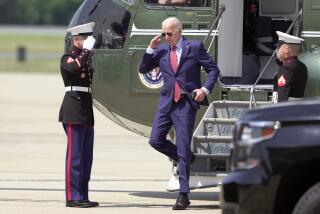New Phase of War on Terror Moves to E. Africa
- Share via
ABOARD THE USS MT. WHITNEY — Amid paper Santas, boughs of holly and a portrait of a bullet-riddled Osama bin Laden, the commander of the next phase of the U.S.-declared war on terror laid down the gauntlet Friday.
“We’re coming, we’re hunting, we’re relentless,” U.S. Marine Maj. Gen. John F. Sattler declared as this high-tech floating intelligence center cruised the troubled waters of the Gulf of Aden. “If they stumble, we’ll bring them to justice. Even if they don’t stumble, if they sleep a little too early one night or a little too late one morning, we’ll be there.”
As the prospect of war with Iraq looms, most eyes are focused on America’s military buildup in the Persian Gulf. But Sattler and his new command ship are emblematic of how U.S. military forces have been beefed up in East Africa as well, in the first major presence in the region since their bitter departure from Somalia nearly a decade ago.
“This fight cannot be put on the back burner,” Sattler said. “The global war on terrorism is continual, regardless of what else happens around the world.”
Sattler on Friday detailed for the first time a new U.S. strategy in eastern Africa to track -- and attack -- terrorist suspects throughout the seven-nation region of Somalia, Yemen, Kenya, Ethiopia, Eritrea, Djibouti and Sudan.
The new mission officially began this week, less than a month after lethal terror attacks in Kenya just down the coast. The mandate is to target Al Qaeda members and other terrorists who, intelligence sources say, have fled Afghanistan for havens here.
Sattler declined to comment on whether last month’s attack by an unmanned CIA Predator drone that killed a carload of Al Qaeda suspects in Yemen was a prototype of the new campaign. But, he added, “if I were a terrorist and I thought I was happily driving down the road with my terrorist buddies and all of a sudden with no warning I cease to exist, I would be looking left, right and, now, up, because we’re out there.”
The Bush administration has yet to outline the rules of engagement of the mission, and the Yemen strike raised legal issues about targeted killings. After the attack, President Bush said only, “The best way to keep America safe from terrorism is to go after terrorists where they plan and hide.”
The centerpiece of the mission here is the Mt. Whitney itself, a U.S. Navy amphibious command ship that has been transformed into a mobile forward base for the effort.
The Horn of Africa is a region of great concern in the anti-terror effort. Bin Laden lived in Sudan for four years in the 1990s. Many of his followers are from Yemen. His suicide bombers have attacked U.S. embassies in Kenya and Tanzania. And the deep poverty of Djibouti, Ethiopia and Eritrea provides rich breeding grounds for future supporters.
Sattler described the mission as “detect, disrupt, defeat and deny.” The goal is to locate terrorists through intelligence from the military, the CIA and international coalition members; dismantle their financial and logistics networks; capture them through arrest or “violent military action”; and then “change the environment so that once we move out, the countries within the Horn of Africa are able to maintain that stable presence.”
“We’re doing everything from hanging doors to hanging curtains to breaking doors and breaking windows,” he said.
Sattler said he will use his seaborne center to deploy air and land assets that include special forces, members of all four armed services and the new U.S. Camp Lemonier in Djibouti. The 80-acre base is America’s first in East Africa since a firefight in Mogadishu, the Somali capital, killed 18 U.S. soldiers and drove the United States from a failed U.N. mission to rebuild Somalia in 1993.
The Mt. Whitney is equipped with an electronic war room, vast databases and constant satellite feeds of the latest real-time intelligence on suspected terror activities across the globe.
“If there is intelligence out there that we can’t receive back on this ship, the next time we go to shore I will buy you the libation of your choice,” Sattler said before allowing a small group of journalists to tour the Whitney’s joint operations center.
But the ship also includes human resources, some of them witnesses to the Somalia mission -- and the toll of terror attacks in the past.
Navy Petty Officer 1st Class Jaja O’Neil was blown 3 feet into the air near the bow of the U.S. destroyer Cole when terrorists rammed it with a suicide boat in nearby Yemen two years ago, killing 17 sailors. On Friday, O’Neil sat in the joint operations center of the Mt. Whitney, just an hour’s sail from the Aden harbor where the attack occurred.
“It’s not about revenge,” said O’Neil, a 29-year-old Chicagoan who volunteered for the mission. “A lot of people from the Cole got out of the Navy after the bombing. I stayed in because I wanted to see that the job was finished.”
O’Neil, who said his first name means “God’s gift” in the Ibo language of Nigeria, still carries the dog tags of shipmates killed in the October 2000 attack in his breast pocket. “I also felt compelled to continually inform my new shipmates about the security of our business -- to not let them let their guard down.”
On deck, Marine Staff Sgt. Chris McDonald of Garden Grove was back in the region for the first time since he manned a checkpoint in Somalia in 1993.
“It’s a different mission,” McDonald said. “We’re going after terrorists, to protect our families back home. Last time, we were trying to help the Somalis out.”
McDonald, 32, is among about 200 Marines aboard the Whitney, most of them part of a quick-reaction force that expects to be deployed on land during the mission. Sattler also might move his command center ashore, but only if it includes the array of intelligence assets available aboard the Whitney.
Sattler outlined a broad mission, ranging from hunting down terrorists to humanitarian work in the seven nations, that is intended to improve their economies, win new friends for America and prevent terrorist bases from springing up in the region after U.S. forces leave.
The strategy is to bring to bear all military and civilian forces in the area to maintain pressure on the terror groups.
“It’s hard to engage somebody with all of your talents and all your spirit when you’re looking over your shoulder,” Sattler said.
“You’re constantly afraid somebody’s breathing down your neck. You’re afraid to use your cell phone. You’re afraid to use your car more than one day, afraid to spend more than one night in a location.”
He acknowledged the difficulties the mission faces.
“We may come up with some empty holes on occasion. We may come up empty-handed if we push into an area,” Sattler said. “But if somebody was there a week or a day prior, and they shut down and moved on, that’s not a failure. That’s a successful operation.
“If it was easy, we would have already done it. But the other option is to do nothing.”
More to Read
Sign up for Essential California
The most important California stories and recommendations in your inbox every morning.
You may occasionally receive promotional content from the Los Angeles Times.










